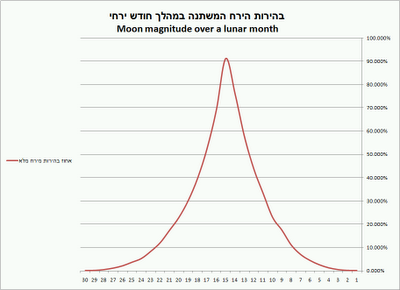A full moon is very bright. So bright that you can read a book by its light. The moon the day before or after is almost as bright, at least it seems to be perfectly round and only a fraction of a percent is not lit, so how much can the brightness change? Actually a lot. Similarly, half moon, is not half the brightness of a full moon but much much less. We will see how the albedo effect influence the moon brightness over a period of a lunar month.
We will present the graph first, and then try to understand the reason for this strange phenomenon, which seems to defy logic.
We will present the graph first, and then try to understand the reason for this strange phenomenon, which seems to defy logic.
 |
| The changes in the moon brightness during a single lunar month. Notice the big daily differences. |
The graph above shows the brightness of the moon in percent from its peak (100%). Please note, that the actual peak is not reached every month, since it depends on the moon's distance from Earth (the moon is a little brighter when it is closer to earth), but the surprise is the curvature of the graph. You can zoom into the graph and see how even the day before full moon, the brightness is only 75%, three days before full moon the brightness is half (While to the eye the circle of the moon looks nearly perfect as more than 90% of the moon is illuminated). The brightness of the half moon is only eight percent of the full moon, and the brightness measured at the beginning of a lunar month is less than a promil of a percent.
Why does this happen? The difference in brightness is due to several reasons. One intuitive. The less the phase of the moon, its brightness decreases. For example, for a half moon, this reason explains half of the decline (but not the other 85% of the decline).
The moon, like everything, has an Albedo. Albedo means the amount of light which is reflected from an object. The Albedo of the moon on average is 0.12 meaning that it returns only 12% from the light that it gets from the sun (this is relatively a low Albedo compared to other planets). But even this little reflection is made only when the moon is lit directly, what happens in the middle of the month. Mid-month light hits the moon at an angle and some of the light does not come to us, in addition to the lunar surface is not smooth but very rough. When the light comes to the moon at an angle (however minor), many areas of the moon surface are not lit and thus, do not reflect light at all. When the angle increases, the percentage of these parts increases, and the moon returns less and less light, resulting in overall decrease of the brightness .
Even when the moon is full, its brightness does not reach a peak (even at maximum closeness to earth). There's always an angle between us and the moon (the moon is not on the same plane as the sun and Earth) and when there is no angle and the moon can indeed return 100% of the light, the Moon will be the shadow of the Earth, we will experience a marvelous full lunar eclipse, and we will not observe the moon at all.
If you have a camera that allows you to control the setup you can test the moon brightness for yourself . Set the camera to measure light from the middle only (Spot). In this way the camera measures light only from the moon (of course put the moon in the middle of the frame). Set the aperture to be fixed (on 5.6 for example) and the ISO (on 100) and let the camera adjust the speed according to the amount of light exposure. Compare the exposure data of a half moon to a full moon over several nights and observe the differences. Full moon exposure time will be the shortest. Please note that the measurement of light must be of the same specific spot on the moon. Even the moon itself has brighter and darker areas.
Even so, the moon, from the second day of the month, is the brightest object in the sky (except for the sun of course). Even then it casts a faint shadow (must be a dark place to see a pale shadow), as the moon waxes it becomes more noticeable, easier to pay attention to its shade. As an exercise, try to stand in dark places on different days of a month and see if you recognize the moon shadow yourself. The moon can be seen in daylight. Note the moon in the daytime and the same moon at night. The bright moon of the night seems so pale in the day and hardly more prominent than the surrounding clouds. The brightness of the moon did not change at all but the brightness of the day sky makes it look paler. An additional factor is that the brightness of the moon relates to its entire area in the skies, while usually for stars and planets the brightness is measured for a little dot. This explanation would clarify why Venus in the photo below looks much brighter than the Moon, despite the fact that the moon's brightness is higher.
 |
| The moon and Venus. Venus looks brighter than the moon although the moon's brightness is higher |